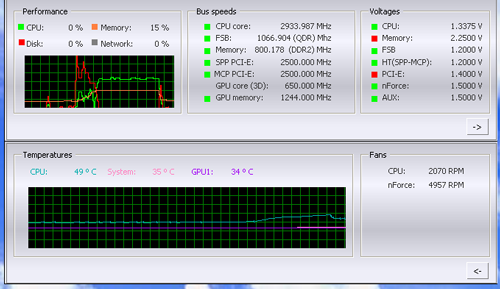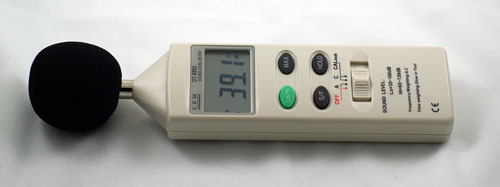Tuniq Tower 120: Air Cooling to the Max
by Wesley Fink on January 15, 2007 12:01 AM EST- Posted in
- Cases/Cooling/PSUs
CPU Cooling Test Configuration
A primary requirement for any cooling test bed is a reliable utility for measuring CPU temperature and fan speed. The utility also must be usable while other programs are running so the impact of stress testing can be assessed. It is not really critically important that the temperature measurements be completely accurate, but results must be consistent and repeatable using the same test setup.After assessing a number of Intel 975/965 and NVIDIA 680i motherboards the decision was reached to use the NVIDIA 680i as the cooling test bed. This was primarily based on the excellent temperature measurement utility, NVIDIA Monitor, which is part of the nTune program.

NVIDIA Monitor has a drop-down pane for temperature measurement which reports CPU, System, and GPU measurement. At this point we will concentrate primarily on CPU temperature with listings of system temps for reference. In addition to the real-time temperature measurement, NVIDIA Monitor also has a logging feature which can record temperature in a file in standard increments (we selected every 4 seconds). This allows recording of temperatures during testing and play back, for example, of stress test results that can then be examined when the stress tests are completed. There is also the handy reference of speeds and voltages in the top pane to confirm the test setup. These factors made NVIDIA Monitor on the 680i the ideal program for evaluating cooling.
Further tests using the program showed results were consistent over the same setup and repeatable under similar conditions. For all of these reasons NVIDIA Monitor on the NVIDIA 680i was used for testing cooling. Other components in the cooling test bed are generally the same as those used in our motherboard and memory test bed:
| Cooling Performance Test Configuration | |
| Processor: | Intel Core 2 Duo X6800 (x2 2.93GHz, 4MB Unified Cache) |
| RAM: | 2x1GB Corsair Dominator PC2-8888 (DDR2-1111) |
| Hard Drive: | Hitachi 250GB SATA2 enabled (16MB Buffer) |
| Video Card: | 1 x EVGA 7900GTX - All Standard Tests |
| Platform Drivers: | NVIDIA 9.53 |
| Video Drivers: | NVIDIA 93.71 |
| CPU Cooling: | Tuniq Tower 120 Intel Stock HSF for X6800 |
| Power Supply: | OCZ PowerStream 520W |
| Motherboard: | EVGA 680i SLI (nVidia 680i) |
| Operating System: | Windows XP Professional SP2 |
| BIOS | Award P23 (12/22/2006) |
The 680i motherboard with NVIDIA Monitor software will allow testing of the cooling efficiency of the cooler under test. We first tested the stock Intel cooler at standard X6800 speed, measuring the CPU temperature at idle and while the CPU was being stressed. We stressed the CPU by running continuous loops of the Far Cry River demo. The same tests were repeated at the highest stable overclock we could achieve with the stock cooler. Stable in this case meant the ability to handle our Far Cry looping for at least 30 minutes.
The same tests were then run on the cooler under test at stock, highest stock cooler OC speed, and the highest OC that could be achieved in the same setup with the cooler being tested. This allows measurement of the cooling efficiency of the test unit compared to stock and the improvement in overclocking capabilities, if any, from using the test cooler.
Noise Levels

In addition to cooling efficiency and overclocking abilities, users shopping for CPU cooling solutions may also be interested in the noise levels of the cooling devices they are considering. Noise levels were measured in various configurations using a C. E. M. DT-8850 Sound Level meter. The C. E. M. meter can measure either A-weighted or C-weighted sound levels. All reported measurements are A-weighted since this is generally considered closer to the way the human ear actually perceives noise.
This meter allows sound level measurements from 35bdB to 130dB with a resolution of 0.1dB and an accuracy of +/- 1.5dB. This is sufficient for our needs in these tests, as measurement starts at the level of a relatively quiet room. Our own test room, with all computers and fans turned off, has a room noise level of 36.4dB. Our procedures for measuring cooling system noise are described on page 6 along with noise results comparing the stock Intel cooler to the Tuniq Tower 120.










50 Comments
View All Comments
EWAXMAN - Sunday, January 6, 2008 - link
TO WHOM THIS MAY CONCERN,
I WOULD LIKE TO SEE A TEST RUN ON THE "ASUS TRITON 77 CPU COOLING FAN" COMPARED TO: THE TUNIQ TOWER 120, THE ZALMAN 9500 LED, AND THE ZALMAN 9700 LED - FOR OVERCLOCKING PURPOSES.
TESTED ON AN INTEL DUAL CORE CPU's 1.86 GHZ 65nm's AND UP, FOR COOLING, EASE OF INSTALLATION, PLUS NOISE FACTOR AS WELL.
THANK YOU IN ADVANCE, FOR YOUR CONSIDERATION, TIME, AND HELP.
RESPECTFULLY SUBMITTED,
EWAXMAN
EWAXMAN - Sunday, January 6, 2008 - link
I WOULD LIKE TO SEE A TEST RUN ON THE "ASUS TRITON 77 CPU COOLING FAN" COMPARED TO: THE TUNIQ TOWER 120, THE ZALMAN 9500 LED, AND THE ZALMAN 9700 LED - FOR OVERCLOCKING PURPOSES.TESTED ON AN INTEL DUAL CORE CPU's 1.86 GHZ 65nm's AND UP, FOR COOLING, EASE OF INSTALLATION, PLUS NOISE FACTOR AS WELL.
THANK YOU IN ADVANCE, FOR YOUR CONSIDERATION, TIME, AND HELP.
RESPECTFULLY SUBMITTED,
EWAXMAN
LoneWolf15 - Wednesday, January 17, 2007 - link
Maybe I missed it...were the temperature results for the Tuniq tower obtained with the fan on minimum or maximum RPM?orion23 - Tuesday, January 16, 2007 - link
So Anandtech, I mean, Anandtech reviews this great cooler and the test that was run compares it to Intel's stock cooler?And the load temperatures are taken from a game and not Orthos, or the well know Prime95?
And what happened, You guys couldn't get a Zalman or Thermalright Cooler to test the tuniq against?
What is wrong with Anandtech?
Jodiuh - Tuesday, January 16, 2007 - link
Most folks use Core Temp to monitor temps since it works the same across all boards. As it stands, only 680i users can compare.And why not use Orthos, the OCer's fav testing tool? It gets temps up pretty high and lets us know how stable a system is.
PrinceGaz - Tuesday, January 16, 2007 - link
You reported the temperatures at stock (2.93GHz) and at 3.73GHz for the standard cooler and the Tuniq Tower 120, and also at 3.83 and 3.9GHz for the TT120, but was the CPU running at the same core-voltage for all these different speeds? Presumably it was running at stock voltage for the stock speed run, so was 3.73GHz and 3.9GHz the maximum it could reach at stock voltage with the two heatsinks, or was the voltage increased (and by how much) to reach those speeds?For pure temperature comparisons between HSFs, keeping the voltage the same is obviously a must. However if the voltage was kept at stock (or at the same raised voltage) for determining the maximum overclock then you are probably missing out on a major advantage of a better cooler which is that you can crank the voltage up somewhat higher and still have a safe temperature.
Overclocking a CPU generally consists of seeing how fast it is stable at, then add a bit more voltage and see how much further it goes (while watching the temps), then a bit more voltage, and so on until the temperature reaches the highest you are happy with. The better HSF will allow a higher voltage to be used and that will usually translate to a higher overclock. Okay, so the overclocked temperature may be just as high with the better HSF when you use that approach, but it should provide a better indication of how much higher you can overclock the CPU with it.
Jiggz - Monday, January 15, 2007 - link
With it's monstrous size and weight, you would think they will design something for a vertically oriented mobo; which by the way most of us have.monsoon - Monday, January 15, 2007 - link
Does anyone know about a good / slick / cheap ( any of those criteria is welcome ) CASE where to install HORIZONTALLY a regular ATX MoBo so that I don't have to worry about the weight of the cooler ?THANKS !=)
Axbattler - Monday, January 15, 2007 - link
Though it is a little redundant (given that I don't see people mounting AMD fans on Intel chips and vice-versa), I am a little curious how well the AMD Stock fan compares to the Tuniq tower, and by association, how well it compares to the Intel.I remember that AMD's heatpipe cooler, used in the Dual-Core Opteron (and probably some other chips) have been very well regarded in various reviews. At the time, it was often thought that AMD's stock cooling solution was a good few steps ahead of Intels. Of course, it is hard to tell if part of the reason may not have been with the sheer amount of heat generated by those P4s, which is why I am curious how the two compares today.
Araemo - Monday, January 15, 2007 - link
I'd guess that that "good" dual core opteron heatpipe heatsink is a good unit. I purchased one in the FT/FS forums after I got my Opteron 148 (Single core, standard A64 heatsink), and with nothing but a little AS5, it was able to get my Opteron stable at 2.4 Ghz(over 1.8) with almost no extra voltage (I was only able to add 0.05V over the stock on my motherboard).That all said.. good luck getting a fair comparison with the Core 2 duo heatsinks.. You can't mount them on AMD and you can't mount the AMD(Socket 939) cooler on Intel(LGA775), as far as I can recall. I seem to recall that a few years back Anandtech(I think it was AT anyways.. I could be mistaken) built a 'cpu simulator' that had little metal ingots with heaters and temperature probes embedded to do apples-to-apples heatsink testing... I wonder if that's a realistic option for this roundup?